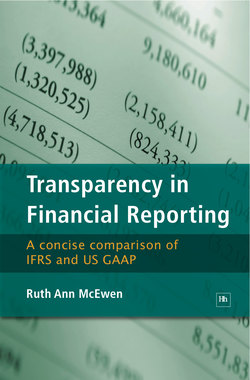Читать книгу Transparency in Financial Reporting - Ruth Ann McEwen - Страница 10
D. Entity-specific estimates
ОглавлениеCON 7 offers justification for using entity-specific estimates. Entities might expect to realize or pay cash flows that differ from those expected by external parties if:
(a) the entity’s managers might intend different use or settlement than that anticipated by others;
(b) the entity’s managers may prefer to accept risk of a liability (like a product warranty) and manage it internally, rather than transferring that liability to another party;
(c) the entity might hold special preferences, like tax or zoning variances, not available to others;
(d) the entity might hold information, trade secrets, or processes that allow it to realize (or avoid paying) cash flows that differ from others’ expectations;
(e) the entity might be able to realize or pay amounts through use of internal resources.
US GAAP does not allow entity-specific measurement. US entities rely extensively on mathematical models, some of which are extremely complex with subjective estimates that can introduce extreme volatility. Take, for example, the Black-Scholes model for estimating the value of employee share based payments. [15] Under the Black-Scholes model, estimates are required for the risk-free rate and the expected volatility of common stock. These estimates are considered to remain constant over the option’s term (not necessarily the case) and assumptions inherent in initial estimates can substantively affect the expense associated with the options, thus affecting income. For example, a Black-Scholes valuation of call options with an exercise price of $20 per share, a stock price at the date of the grant of $20 per share, an expected life of the option of 5 years, and no dividends would be $6.07 if the initial estimates of the risk-free rate and volatility are 6.5% and 15%, respectively. If the initial estimates are 5.0% and 10%, respectively, the valuation is reduced to $4.67, a reduction of 23% in employee compensation expense. Note that the Black-Scholes model requires assumptions that options are freely traded and that the option life is relatively short term. Neither of these assumptions is true for employee share-based payments, but the model is considered to be robust to violations of its assumptions.
IFRS does allow entity-specific estimates and requires extensive disclosure about cash flows and other fair value estimates, especially when entity-specific measures have been used. Entities may well publish the assumptions underlying their estimates in the notes to the financial statements. However, predicting volatility in markets that are not fully functioning is an uncertain task. Thus, fair valuation even with extensive disclosure may not enhance usefulness or meet the objectives of transparency. And since remeasurement gains and losses are recognized directly into income, slight changes in estimates hold the potential to affect earnings. Current accounting research suggests that valuation based on standards that are unstructured or less transparent, such as Level 3 unobservable inputs, provides a setting where managers are likely to manipulate earnings. [16] In applying that technique an entity’s assumptions should be realistic; however, US GAAP guidance allows considerable latitude in estimating Level 3 unobservable inputs.
Such discretion calls into question the effects of fair valuation inherent in the asset/liability approach on transparency and quality of financial reporting. McInnes and Cataldo (2007) offer a particularly stinging criticism of the asset/liability approach. They state:
Many otherwise well informed accounting and finance professionals seem unaware of the radical impact that fair value would have on our financial reporting system. According to the fair value vision, the entire framework of transaction-based accrual accounting would be replaced by a system that measures every asset and liability at an estimate of its current “fair value.” Traditional concepts of revenue, expense, and matching have no place in this vision. What we currently understand as “net income” would be redefined as the change in book equity – that is, the difference between the estimated fair values of assets and liabilities, adjusted for primary capital flows. This system of comprehensive fair value accounting is known as the asset-liability approach. [17]
Noting that historic cost may be of greater use than fair value in predicting future cash flows, especially with the advent of more principles-based IFRS, McInnes and Cataldo (2007) reiterate the assertions of numerous critics of fair value accounting:
The adoption of full fair value accounting for all assets and liabilities and convergence with IFRS will present challenges for preparers and users alike, perhaps with little benefit, and with the nontrivial possibility of great harm.
12 IAS 18, ¶ 7. [return to text]
13 Note that subsequent sections of this book will discuss FASB’s Codification project and the terminology which will be required to reference authoritative guidance after July 1, 2009. [return to text]
14 FAS 157, paragraph 21. [return to text]
15 Black, Fischer and Myron Scholes, “The Pricing of Options and Corporate Liabilities”, The Journal of Political Economy 81:3 (May-June 1973), pp. 637-654. [return to text]
16 J. Hunton, R. Libby, C. Mazza, “Financial reporting transparency and earnings management” The Accounting Review 81, pp. 135-157. [return to text]
17 M. McInnes and J. Cataldo, “SFAS 159: The Fair Value Option”, The CPA Journal, August 2007, http://findarticles.com/p/articles/mi_qa5346/is_200708/ai_n21293122/pg_1. [return to text]
